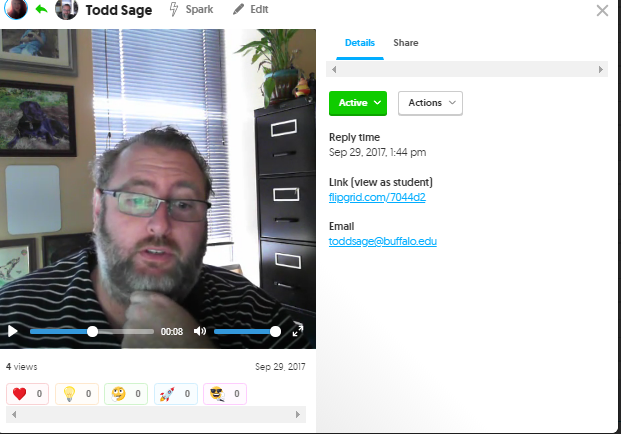Incorporating Flipgrid into the Social Work Classroom: Tips for #SocWorkEd
Todd Sage is a social work educator at the University at Buffalo, and a Doctoral Student in Teaching and Learning: Higher Education at the University of North Dakota. In this blog post, he shares his tips for educators on how to use Flipgrid to enhance online learning and develop class community. Todd can be reached at ToddSage@Buffalo.edu. Follow him on Twitter: @socialworksage.
In 2017, new National Association of Social Workers’ Standards for Technology in Social Work Practice were issued to address the intersections of social work practice and technology. These standards encourage educators to equip social work students with technology skills that will prepare them for tech-mediated practice. Student exposure to classroom technology primarily happens through Learning Management Systems such as Blackboard and Adobe Connect, which can be useful tools for online teaching, but are geared for educational users are rarely used in the practice world.
To prepare the next generation of social workers, it is vital that social work educators inform students about readily available collaboration platforms that are transferable to real world practice. It gives students an opportunity to learn a new tool, evaluate its pros and cons, and think about how these tools can be applied to future practice. On some occasions, the tools also work much better than institutional platforms.
When I taught Motivational Interviewing last term in a primarily asynchronous setting, I didn’t know how I would use the existing institutional tools to teach interview skills. This is why I was happy to find Flipgrid. This platform works like a discussion board, only all the content is short video clips, and the desktop and phone-app platforms are so easy to use that even kindergarten teachers have students create videos.
What is Flipgrid? Flipgrid describes their website as one “… that allows teachers to create “grids” of short discussion-style questions that students respond to through recorded videos. Each grid is effectively a message board where teachers can pose a question and their students can post 90-second video responses that appear in a tiled “grid” display”(Flipgrid, n.d).
Flipgrid works across all types of operating systems (Mac, Windows, Android, and iOS) and web browsers (Chrome, Bing, Firefox, etc) and, in my experience, has a shallow learning curve, allowing learners to quickly adapt to the format. There are currently two pricing plans for Flipgrid: a free version that limits the class instructor to one discussion thread and allows for up to 90 second video responses or a paid version, $65 a year, that allows multiple discussion threads with up to 5 minute responses and the inclusion of rubrics and other advanced features. Grids can be invite-only, password protected, or open to anyone who has a link.
In my experience, either version can enhance a course and is a refreshing change from similar discussion tools built into learning management systems. In the Fall of 2018, I utilized Flipgrid extensively for my online asynchronous Motivational Interviewing (MI) course. Flipgrid allowed me to post examples of MI for students to critique, and post reflections on as well as videos of them practicing MI for me to reply to. The recording, posting and replying to topics is done quickly and seamlessly within the application. This allows for ease in scaffolding learning, an important element in any clinical course. See Screenshot #2 for an example of what a topic grid looks like within the app.
Evaluation of students is done quickly within the application either by written feedback or video feedback. You can also use emojis to quickly provide a reflection on the post. See Screenshot #1 for a look at me leaving a video feedback to a student.
My feedback from students is that they enjoy the platform and like that they can access it both from their computers and their smartphones. Students have shared that it allowed them to get to know me better as the instructor as well as their peers. In asynchronous classes especially, it can be hard to know whether students are integrating skills, and this allows a non-written assessment of student work. I also use Flipgrid as my announcement board, sending out video updates again as a way to allow the students online to see me and get to know me.
Opportunities to use Flipgrid in class are fairly boundless… you can have students collaborate with another class of students at another institution or even in another country; have them react to readings; give each other feedback; or demonstrate skills. See more about what Flipgrid looks like in practice at their Vimeo Channel: https://vimeo.com/flipgrid
Want to try flipgrid? Use this code TODDSAGE for an extended free trial. The code TODDSAGE is active for an unlimited number of people to launch a 45-Day Trial of Flipgrid Classroom!
See how others are using Flipgrid by following the #flipgridfever hashtag on Twitter.
Share how you are using Flipgrid by replying to this post here or on Twitter!
References:
Flidprid (n.d.) Homepage. Retrieved from: https://flipgrid.com/
How to cite this post:
Sage, T. (2018, June 4). Incorporating Flipgrid into the Social Work Classroom: Tips for #SocWorkEd [Blog Post]. Retrieved from: https://laureliversonhitchcock.org/2018/06/04/incorporating-flipgrid-into-the-social-work-classroom-tips-for-socworked/





January 11, 2019
Hi, I am using flipgrid to keep my field students connected and to spur timely discussions. For example, the month before field started, I got them on to introduce their agencies then tell what they would read over the break to prepare them for their experience. I also had them report out the night before field along with something fun like what they were wearing and packing for lunch.
January 11, 2019
Cindy, I love this use of Flipgrid for Field Education! I just started using Flipgrid this semester, thanks to the encouragement of my colleague Todd Sage at the University at Buffalo. One of the features I like about Flipgrid is that you can easily and users from the community, that is individuals who do not have an institutional email address, which are most of our field supervisors. I want to learn more about how you are using this software for field.